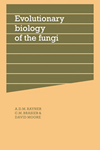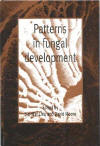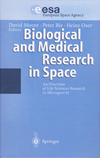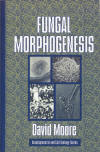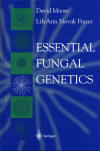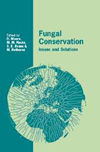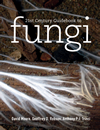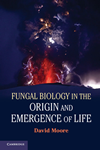14. Education: school, public awareness and Internet
I was on the academic lecturing staff of the University of Manchester for 43 years and was involved in university-level education for all of that time. For at least 30 years I was responsible for teaching courses in basic genetics, and when I moved on to other topics I collected together the lecture notes and other teaching aids into an undergraduate level textbook entitled Essential Fungal Genetics (Moore & Novak Frazer, 2002).
Essential Fungal Genetics Through their teaching and research in fungal genetics at the University of Manchester (UK), Moore and Frazer are well qualified to write this book. Their goal is to integrate fungal genetics into current teaching by complementing major textbooks used in courses in general genetics, general organismal biology, and general mycology. This book differs from others on fungal genetics in that the examples chosen to illustrate various features tend to favour basidiomycetes and the less-often referenced fungi. To maintain a readable style of presentation, the authors have omitted reference citations in the text. Important references are listed at the end of each chapter, with emphasis on review articles and Web sites. Ten chapters treat important aspects including genome interactions, wild types and mutants, segregation genetics, recombination analysis, mechanisms of recombination, the physical genotype, mapping the fungal genome, fungal phylogeny and evolution, and fungal differentiation and morphogenesis. This book will serve as a comprehensive resource for courses in fungal genetics and will be useful for upper-division undergraduate and graduate students as well as professionals in molecular fungal biology, mycology, plant pathology, microbiology, medical mycology and other disciplines in which fungi have an important role. R. L. Gilbertson, emeritus, University of Arizona; from ChoiceReviews.online at www.choicereviews.org © American Library Association. The publication of a general text devoted entirely to fungal genetics is a welcome, but not common event. Publication at this time has allowed the authors to cover traditional genetics, such as mutation and recombination, while including the latest molecular biology. The book contains a wealth of useful information ... the text has many diagrams ... Starting each chapter is an extensive list of ‘revision concepts’ ... The text is not directly referenced, but lists of publications and websites ‘worth a visit’ or ‘worth knowing about’ are given at the end of each chapter ... this is a valuable contribution on these fascinating and important organisms. Roger Marchant, University of Ulster, Coleraine, Northern Ireland; appeared in Microbiology Today (quarterly magazine of the Society for General Microbiology), volume 30, page 91, May 2003. The authors have undoubtedly succeeded in their main aim of producing a readable yet challenging text which will appeal to keen undergraduates and their teachers alike. In particular, the inclusion of both classical and molecular techniques together makes for a satisfying read. Each chapter is organised logically and carefully leads the reader through, at times, complex ideas. I found the figures and tables particularly useful ... the inclusion of revision notes does suggest a target group of undergraduates ... this is a valuable addition to the literature which I will certainly recommend as a reference source for our final year undergraduates studying fungal genetics. Paul Hooley, School of Applied Sciences, University of Wolverhampton, West Midlands WV1 1SB, UK. Review in Mycological Research (2002) vol. 106, p. 1488. |
Extracts from published reviews of Moore, D. & Novak Frazer, L. (2002). Essential Fungal Genetics. New York: Springer-Verlag. ISBN-10: 0-387-95367-1, ISBN13: 978–0387953670. Softcover ISBN13: 978-1441929747. URL: http://springerlink.com/content/978-0-387-95367-0. |
When I finally retired from the University I completed a similar exercise with the lectures and other material created for courses on fungal biology to which I had contributed and, with two colleagues who had also lectured on these courses produced the textbook 21st Century Guidebook to Fungi (Moore, Robson & Trinci, 2011).
21st Century Guidebook to Fungi A modern mycological textbook for use in advanced university courses has been much needed, as there have already been so many advances in our understanding of their genetics, development, and relationships this century. This book grew out of courses the authors have taught at the University of Manchester for many years. It aims to capture the excitement, and present a new look, of fungi as they are now understood in a “systems biology” framework, emphasising interactions with other organisms, adopting an integrated rather than a reductionist approach, utilising modelling and bioinformatics when appropriate - and enhancing accessibility by an accompanying CD not just with the entire text, but also hyperlinks to both key websites and cited references ... there is an Appendix which includes descriptions down to order with example genera indicated. The coverage of uses of fungi is particularly extensive and informative, and also well-illustrated ... A major innovation and “plus” for this work is the CD. The imbedded hyperlinks are not just to an extraordinary number of websites, but to all cited original papers with DOI numbers ... I was most impressed by the speed at which links were made ... a click on a book title or chapter can take you directly to the publisher’s sales page. Those fortunate to be located at institutions with electronic subscriptions to journals that are not open access, however, will quickly reach the full-texts. This ability to link students directly from a textbook to primary research papers is really exciting and sure to enthuse ... I particularly liked the line drawings incorporating colour explaining ultrastructural and developmental features. The quality of the colour photographs on the CD is superb … a second Appendix … provides a splendid account of the terminology of mycological structures from mycelia to sporophores, and including conidiogenesis patterns, and types of asci, basidia, hyphae, sporophores, and tissues … There can be no doubt, however, that this will be great as a main text for mycology courses at advanced degree and masters levels, and also a valuable sourcebook for up-to-date information on diverse aspects for the subject. The authors can be proud of this achievement, which has the potential to enthuse and inspire a new generation of experimental mycologists. I cannot commend it too highly, and am recommending on the postgraduate courses to which I contribute. David L. Hawksworth; from IMA Fungus, Volume 3 No.1 April/May, 2012. 'Mycology is often seen as a relatively small specialist discipline; however, this expansive treatment of the subject reaches the parts that other textbooks fail to reach, even putting fungi in the context of the cosmos! This interactive textbook will make a valuable contribution to modernising fungal science education, providing a platform for 21st century mycology teaching in universities and colleges.' Dr Alison M. Ashby, University of Cambridge. Amazon customer review 27 Nov 2012: Very detailed book, very interesting. Great book with very in depth information about fungal biology and all aspects. Also great diagrams and useful pictures with example case studies. Not a mycologist but very interested, I found all matters are well explained with diagrams and very understandable. This 5-star review is by Rob - Amazon verified Purchase. |
Extracts from published reviews of Moore, D., Robson, G. D. & Trinci, A. P. J. (2011). 21st Century Guidebook to Fungi. Cambridge, UK: Cambridge University Press. ISBN: 9780521186957. URL: http://www.cambridge.org/gb/knowledge/isbn/item6026594/?site_locale=en_GB. View Amazon page. |
In 1985, and in collaboration with Patricia Pukkila, I published in the Journal of Biological Education a description of Coprinopsis cinerea that was intended to bring the teaching potential of the organism to the attention of school teachers (Moore & Pukkila, 1985). This was my first attempt at school-level education and it remains an excellent little summary of the cultivation and experimental methods applicable to this organism, which is representative of many other filamentous fungi. Coprinopsis provides the opportunity to demonstrate microbiological techniques with an amenable organism which can also be used to illustrate gene segregations, and cytological, biochemical, and morphological aspects of the morphogenesis of highly differentiated mushroom fruit bodies. I must point out the acknowledgement printed at the end of this paper: ‘We wish to thank Mr Douglas Adams and the Sirius Cybernetics Corporation for the invocation to share and enjoy’ which demonstrates an enthusiasm (that persists) to The Hitchhiker’s Guide to the Galaxy! More recently than 1985, some other writers have reviewed aspects of the biology of Coprinopsis cinerea: Kües (2000), Kamada (2002), Srivilai & Loutchanwoot (2009). My attention had turned to the broader issue of the generally diminishing level of teaching of basic mycology by the the year 2000 when I published my general interest book, Slayers, Saviors, Servants and Sex, which was aimed at the 'man in the street' (Moore, 2000).
Slayers, Saviors, Servants and Sex. An exposé of Kingdom Fungi Fungi are important. This is the central message of Moore's book and one that he illustrates with numerous examples. Fungal diseases kill humans, kill crops and rot harvested foods. In describing the spectacular epidemics and diseases caused by fungi the book is compelling. The symptoms of St Anthony's fire, for example, are given in grisly detail: burning fevers, hallucinations, swollen limbs, severe inflammation followed by numbing of the extremities and complete loss of fingers, toes, arms and legs. All are caused by the ergot fungus Claviceps purpurea, consumed in contaminated rye bread. One outbreak of the disease reputedly killed 40,000 people in France in AD 944, and ergotism has even been suggested to have been the cause of symptoms that took hold of eight young girls in Salem and led to the witch trials of 1692. This story, and the production of potent toxins such as amanitin and aflatoxin, are used to demonstrate that fungi demand our respect. The beneficial applications of fungi, from gastronomy to bioremediation, are given equal coverage. Fungi are, of course, well known as producers of antibiotics, and the story of the discovery of penicillin has been told many times. But our modern dependence on antibiotics is poignantly illustrated here by the story of Albert Alexander, a British policeman who died in 1941 after being scratched by a rose thorn. Initial treatment with the newly available penicillin made him well enough to sit up in bed, but he quickly succumbed to his infected wound once supplies of the drug ran out. The discovery and application of the immunosuppressant cyclosporin, and the best-selling cholesterol-lowering agents, the statins - both natural fungal products - are similarly well described. Although relatively light-hearted and anecdotal in style, there is a serious underlying theme throughout the book, because David Moore is clearly not a happy man. He is unhappy that fungi are viewed only as curiosities and consequently occupy, in his view, the peripheries of mainstream science. Ignored by biology departments pensioning off mycologists, by funding agencies, simplistic politicians and international development bodies, fungi offer tremendous untapped potential but are constantly overlooked. Having devoted a career to their study, Moore wants us to know he is annoyed. He also describes the history of mycology as littered with the 'nearly' men of science: the Reverend Miles J. Berkeley, who studied the origin of the potato-blight epidemic and anticipated the germ theory of Louis Pasteur by almost 25 years, but did not prove his case; and Agostino Bassi who, similarly, recognised fungi as agents of disease at an even earlier date. … I would recommend this book particularly to those who know, or currently care, little about fungi. They will learn a lot in this easy read, and they can even try the anagrams at the back of the book. Here I learned that 'fantastic ugly mess' is an anagram of 'fungal systematics', which should upset the taxonomists. Nicholas J. Talbot; School of Biological Sciences, University of Exeter, Exeter, UK; in Nature 414, 252 - 253 (2001) © Macmillan Publishers Ltd. |
Extracts of a review of Moore, D. (2000). Slayers, Saviors, Servants and Sex. An exposé of Kingdom Fungi. New York: Springer-Verlag. ISBN-10: 0387951016, ISBN-13: 9780387951010. URL: http://www.springer.com/life+sciences/microbiology/book/978-0-387-95098-3. |
In the early years of this 21st century the British Mycological Society (BMS) became aware of declining sympathy for research and scholarship in mycology as the need for economies in costs in several institutions were met by offering early retirement or even outright redundancy specifically to taxonomists and mycologists. It was evident that very little value was placed on knowledge of fungal biology; and it was also very evident that this value judgement was being made by senior scientists who were completely ignorant of fungi. We came to realise that ignorance of fungi was widespread outside the limited population represented by the BMS and this was based on the sound educational principle in schools that ‘we don’t teach it if it’s not in the National Curriculum’. Since the UK National Curriculum for schools was established by the Education Reform Act of 1988 there has been a complete absence of any mention of fungi. In fact the word ‘fungus’ did not appear in the 87-page 1999 edition of the National Curriculum Programme of Study for Science, which is the statutory instrument that defines the curriculum for Key Stages 1-4 (ages 5 to 16) in UK schools (outside of Scotland). A phrase I have used to describe the situation is: 'The one place it is almost impossible to find fungi is in the UK national curriculum for schools'. The BMS reaction to the decline in teaching of its science was to appoint me to develop a programme to:
- Encourage teachers in primary and secondary schools to recognise the value of fungi and their importance in our everyday lives by providing easy access to teaching resources and promoting these in every way possible;
- Engage with the public directly to advance awareness of the role of fungi in everyday life with a mobile display that travelled around the country to promote fungi and fungal biology to the general public.
My first efforts were to develop a few posters, leaflets and other resources that might interest the general public at exhibitions and other displays. Fungus models and live fungi (as the season permitted) attracted the public to the display. Once snared by this attraction the visitor was shown (in display posters and take-away leaflets) the whole range of fungal science, supermarket biotechnology, garden biodiversity, impact on health, and all the rest. The displays rapidly enlarged and developed into the BMS Roadshow. We took care to ensure that the content of the Roadshow addressed the entire span of human existence, from breakfast to supper; from food to pharmaceutical; from habitat to household. By showing how much we all depend on fungi, the BMS Roadshow made the links between science, its practical application and its relevance to daily life. Eventually, the BMS Roadshow comprised an exhibition of over 20 square metres of mobile display boards, educational models, posters, booklets, leaflets, with a staff of enthusiastic volunteers that travelled around the UK (Moore & Moore, 2006).
The BMS Roadshow contributed to a total of 34 events while I was in charge of it, including events organised for National Science Week, several Excellence in Cities programmes, and Science Fairs and Science Festivals. The backbone of the Roadshow calendar, though, was the Royal Horticultural Society’s Flower Show programme. The BMS contributed displays to the RHS Chelsea Flower Show for several years, but the BMS Roadshow exhibited at RHS shows around the country, appearing at the Tatton Park Flower Show in July, the Malvern Spring Gardening Show in May, and Malvern Autumn Garden and Country Show towards the end of September. Our displays always attracted enormous public interest. In July 2004 (the first time it was submitted for judging) the BMS Roadshow was awarded a Silver-Gilt Lindley Medal at the RHS Tatton Park Flower Show, and success continued with a Gold Medal at the Malvern Autumn Garden and Country Show in 2004, a Silver-Gilt at the Malvern Spring Gardening Show 2005, Gold again at both Tatton Park 2005 and the Malvern Autumn Show 2005, and Silver at the Chelsea Flower Show 2006. The total 'through the turnstile' audience of all these shows totals something like one million people and even if only a small fraction of that total stops at our displays, then we communicated awareness of fungal biology to a crowd that would fill a Premiership football stadium! That's an audience that few other academics can claim.
To cater to an even larger audience I developed, with BMS sponsorship, a website called fungi4schools, which was not itself intended to be a teaching exercise, but was instead to be a means for school teachers to access the considerable range of resources the British Mycological Society had published in its own journals over many years. Of course, the core of fungi4schools was the collection of resources developed by my own students (Moore, Fryer, Quinn, Roberts & Townley, 2005). You can still visit my original version of fungi4schools elsewhere on this website (http://www.davidmoore.org.uk/Assets/fungi4schools/index.htm).
I was particularly fortunate during academic year 2003/2004 to have four third year undergraduate project students working with me. Kelly Fryer, Charlotte Quinn, Stephanie Roberts and Ruth Townley did an outstanding job surveying the National Curriculum to produce an academic critique, and then, with the aid of teachers in local schools and at the Manchester Museum, developing teaching resources that actually worked in schools. Those resources were eventually edited to a form suitable for publication in freely downloadable form on the fungi4schools website (which itself followed a pattern developed by Kelly Fryer. I was eventually able to draw their academic critiques together into a paper entitled ‘How much are your children taught about fungi in school?’ which was published in 2005 (Moore, Fryer, Quinn, Roberts & Townley, 2005). In this paper we were able to show that although fungi are fundamentally important in our everyday lives, the Kingdom is largely ignored by the National Curriculum in the United Kingdom. Although specifications then current all contained material about the animal and plant kingdoms, there was little or no consideration of the largest group of higher organisms on Earth: kingdom Fungi. Inevitably, children leave school knowing very little about what is scientifically and commercially an extremely important Kingdom. More importantly, they leave school with a distorted understanding of the living world. We suggested that this would come as a surprise to parents who might expect science teaching to provide a properly balanced foundation to their children's education and future life. The paper showed the deficiencies in the curriculum specifications in UK primary and secondary schools, and described a range of British Mycological Society learning resources designed to remedy the situation. These ready-made (and classroom-tested) lessons and workshop sessions cover a range of fungal topics from cell structure and function, through biotechnology to health topics and plant growth and disease. The resources include games and activities, aiming to increase knowledge and awareness of fungi in an active, entertaining way and thereby maintain interest in biology as a science; and all can be obtained by download from fungi4schools (Moore, Fryer, Quinn, Roberts & Townley, 2005).
In 2005/2006 I made a deliberate attempt to promote all this educational activity by writing notes conveying much the same message to as wide a range of school education contacts as possible. This effort resulted in the following publications:
- The Times Educational Supplement, January 6th, 2006, of an article entitled ‘Mushroom surprise. More than a mushroom: the low-down on fungi for all key stages’ (Moore, Roberts, Quinn, Townley & Fryer, 2006).
- The School Science Review, an article entitled ‘A day in the life of … a mycologist’ (Moore, 2006a).
- The Teaching Ecology Newsletter (published by the British Ecological Society) of an article entitled ‘Now where did we lose Kingdom Fungi?’ (Moore, 2006b).
- The Mycologist published an extensive (illustrated) description of our new website under the title ‘fungi4schools - the new BMS education website’ (Moore, 2006c).
- The School Science Review was again very helpful by publishing an article entitled ‘Fungi 4 Schools - the website’ (Moore, 2006d).
- The School Science Review then came back to me to ask if I could provide a cover illustration for their December 2006 issue; silly question [view Clustered Brittlestem, Psathyrella multipedata cover image].
- English Nature Magazine requested a short article, and I sent them one entitled ‘Please Miss: what’s happened to Kingdom Fungi?’ in October 2006, but this was probably not published as the magazine ceased publication in July 2006 when English Nature became Natural England (Moore, 2006e).
- North West Fungus Group Newsletter, October issue published an article entitled ‘Dear Parents, we regret to inform you that the curriculum does not include fungi’ (Moore, 2006f).
- The European academic journal Sydowia published an editorial entitled ‘Are your children taught anything about fungi at school?’ (Moore & Pöder, 2006).
- The international journal Mycological Research published a news item entitled ‘Crisis in teaching future generations about fungi’ which was co-authored by colleagues in Europe, USA, South America and Australia (Moore, Pöder, Molitoris, Money, Figlas & Lebel, 2006).
- I gave display/presentations under the title ‘Fungus: a day in your life’ (based on the comic-style illustrations to which reference is made in the next item) to pupils at a Science Fair at Cheadle & Marple Sixth Form College (Moore, 2006g).
- With the aid of grant moneys from the Biotechnology and Biological Sciences Research Council and BMS produced a printed comic-style publication entitled ‘Fungus: a day in your life’ (Moore & Elliott, 2006).
Retirement from the University gave me the freedom to complete major writing projects that had been ticking over in the deeper recesses of my mind for some years. The first of these was our textbook of general fungal biology 21st Century Guidebook to Fungi. The third item on this mental list was Coprinopsis: an autobiography, the text you are reading at the moment. Between these two I turned my attention to the fundamental question of biology: that is, the origin of life itself. I had to learn a lot about this to write the appropriate sections of ‘the Guidebook’, but although I had to stick to the conventional line of argument for the textbook, I must say that I found the orthodox story unadventurous, biologically ignorant and rather fanciful. I researched the topic further and during 2012 wrote what I first hoped to entitle The Mycologist’s Tale. My publisher didn’t like that title, so in January 2013 Cambridge University Press published my book entitled Fungal Biology in the Origin and Emergence of Life. I think you should read it. It’s time you learned the truth!
[TOP]
Fungal Biology in the Origin and Emergence of Life The rhythm of life on Earth includes several strong themes contributed by Kingdom Fungi. So why are fungi ignored when theorists ponder the origin of life? Casting aside common theories that life originated in an oceanic primeval soup, in a deep, hot place, or even a warm little pond, this is a mycological perspective on the emergence of life on Earth. The author traces the crucial role played by the first biofilms – products of aerosols, storms, volcanic plumes and rainout from a turbulent atmosphere – which formed in volcanic caves 4 billion years ago. Moore describes how these biofilms contributed to the formation of the first prokaryotic cells, and later, unicellular stem eukaryotes, highlighting the role of the fungal grade of organisation in the evolution of higher organisms. Based on the latest research, this is a unique account of the origin of life and its evolutionary diversity to the present day. • Proposes a new and unique view of the origin and evolution of life on Earth, weaving the evolution of fungi into the evolution of eukaryotes Review: '... Fungi and animals share a deep Precambrian root from which our unicellular ancestors diverged more than one billion years ago. This common beginning is evident when we look at similarities between fungus and animal at the level of genes and proteins, as well as the grander disjunction between both groups of eukaryotes and every other form of life on earth. Mycologist David Moore details the evolutionary history of the fungi in his new book and its relationship to the origins and subsequent development of life on land. This rich and compelling story provides a crucial mycological perspective on some of the biggest questions in modern biology.' Nicholas Money, Professor of Botany, Miami University of Ohio, Oxford, Ohio, USA. Review: 'In a wonderful introduction to this wide and exciting subject, and ensuring accessibility to non-specialist readers, key features of fungal biology are introduced, as is current thinking on the beginnings of the solar system, the formation of the earth and its moon, and the possible origins of the building blocks of life, including panspermia, the ET origin of life on earth. |
Moore, D. (2013). Fungal Biology in the Origin and Emergence of Life. Cambridge, UK: Cambridge University Press. 230 pp. ISBN-10: 1107652774, ISBN-13: 978-1107652774. Visit the publisher’s website, and/or the Amazon page. |
Updated December 7, 2016


